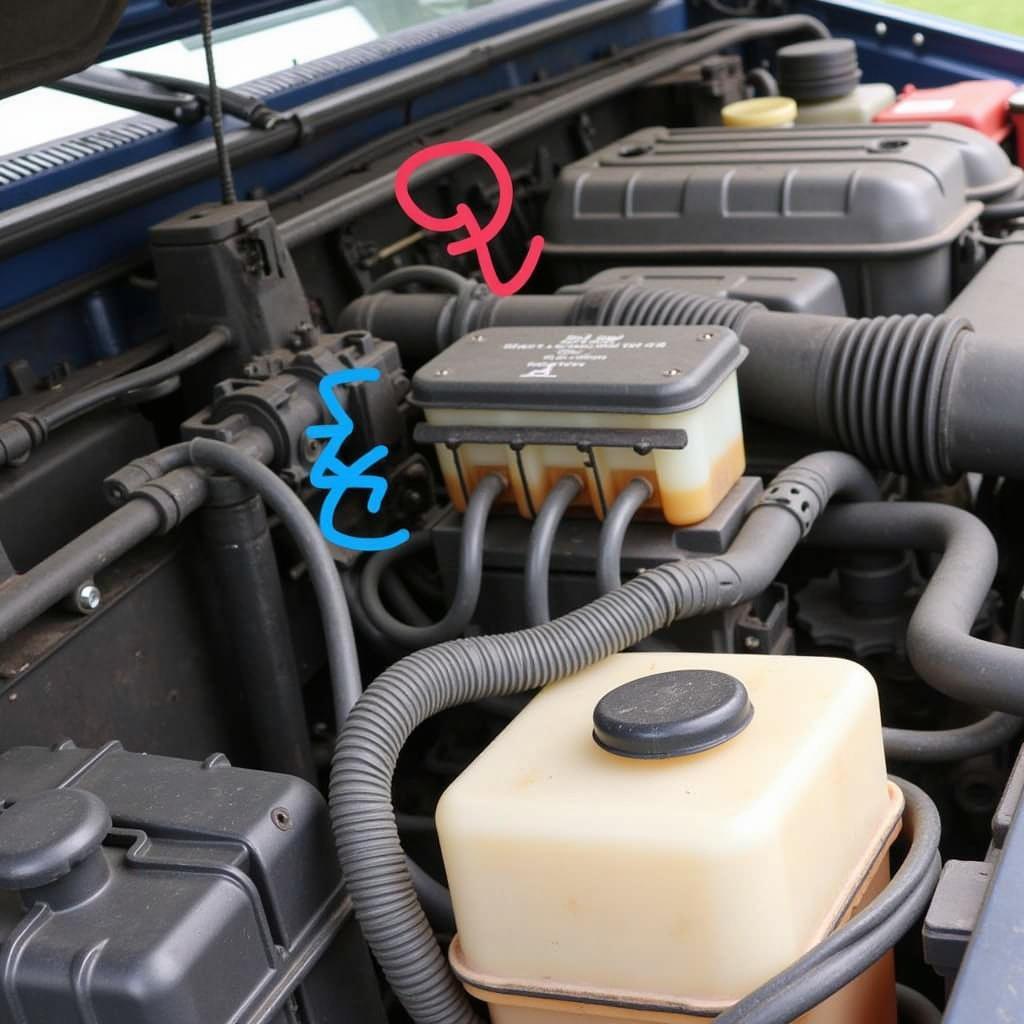The brake warning light on your Ford F650 is a crucial safety feature, illuminating when the vehicle’s onboard computer detects an issue within the braking system. This light serves as an early warning, prompting you to address potential problems before they escalate into dangerous situations. Ignoring this warning could lead to compromised braking performance, jeopardizing your safety and that of others on the road.
Let’s delve into the common causes behind an illuminated F650 brake warning light and explore the steps to effectively troubleshoot and resolve these issues.
Understanding Your F650’s Brake System
Before diving into troubleshooting, it’s beneficial to understand the basics of your F650’s braking system. It’s comprised of several key components:
- Hydraulic System: This system uses brake fluid to transmit force from the brake pedal to the wheels, enabling the vehicle to slow down and stop.
- Brake Master Cylinder: This cylinder is responsible for converting the mechanical force applied to the brake pedal into hydraulic pressure within the brake lines.
- Brake Calipers and Wheel Cylinders: These components house pistons that press the brake pads against the rotors (disc brakes) or drums (drum brakes), creating the friction needed to stop the vehicle.
- Brake Lines and Hoses: These carry the pressurized brake fluid from the master cylinder to the calipers and wheel cylinders.
- Electronic Brake System (EBS): The F650, particularly newer models, is equipped with an EBS that works in conjunction with the traditional hydraulic system. The EBS includes sensors that monitor various parameters like wheel speed and brake pressure, providing input to the vehicle’s control module for optimal braking performance and safety features like ABS (Anti-lock Braking System).
Common Causes of an F650 Brake Warning Light
There are several reasons why your F650’s brake warning light might be on:
- Low Brake Fluid: This is one of the most common reasons. A leak in the brake lines or a worn-out master cylinder can lead to low fluid levels, compromising braking performance.
- Worn Brake Pads: Over time, brake pads wear down naturally. When they reach a certain level of wear, a sensor (in vehicles with electronic wear sensors) triggers the warning light.
- Faulty Brake Light Switch: The brake light switch activates your brake lights when you press the pedal. A malfunctioning switch can also illuminate the brake warning light.
- ABS Issue: While less common, a problem with the Anti-lock Braking System (ABS), such as a faulty sensor or control module, can trigger the warning light.
- Parking Brake Engaged: A simple yet often overlooked cause is an improperly disengaged or partially engaged parking brake.
Troubleshooting the Brake Warning Light
Here’s a step-by-step guide to help you troubleshoot the brake warning light on your F650:
- Check the Parking Brake: Begin with the simplest possibility. Ensure your parking brake is fully released.
- Inspect Brake Fluid Level: Locate the brake fluid reservoir (refer to your owner’s manual) and check the fluid level. It should be between the “Min” and “Max” lines.
- Visual Inspection: Carefully examine the brake lines and hoses for any signs of leaks, cracks, or damage. Pay close attention to the areas around the wheels and near the master cylinder.
- Check Brake Pad Wear: If your F650 is equipped with electronic wear sensors, worn brake pads will trigger the warning light. However, it’s a good practice to visually inspect the brake pad thickness through the wheel spokes.
 Checking Brake Fluid Level in Ford F650
Checking Brake Fluid Level in Ford F650
When to Seek Professional Help
While some brake issues can be addressed with basic troubleshooting, it’s crucial to seek professional assistance if:
- You detect a brake fluid leak: This requires immediate attention as it directly affects your ability to stop safely.
- The brake warning light remains illuminated after adding brake fluid: This indicates a more serious problem that needs professional diagnosis.
- You experience any unusual braking behavior: This includes a spongy brake pedal, unusual noises when braking, or the vehicle pulling to one side when braking.
- You are uncomfortable performing the troubleshooting steps: Braking systems are critical safety components. Don’t hesitate to seek help if you’re unsure about any aspect of the process.
 Professional Mechanic Inspecting Ford F650 Brakes
Professional Mechanic Inspecting Ford F650 Brakes
The Importance of Regular Brake Maintenance
Regular brake system maintenance is essential for optimal performance and safety. Adhering to a maintenance schedule that includes:
- Regular Brake Fluid Flushes: Brake fluid can absorb moisture over time, reducing its effectiveness. Consult your owner’s manual for recommended fluid flush intervals.
- Timely Brake Pad Replacements: Don’t wait for your brake pads to wear down completely. Replace them at the recommended intervals or sooner if you notice any signs of wear.
- Routine Inspections: Regular visual inspections of your brake lines, hoses, and other components can help identify potential issues before they become major problems.
Remote Diagnostics and Software Solutions
Advancements in automotive technology have led to the development of sophisticated diagnostic tools and software that can identify issues with remarkable accuracy. These tools are invaluable for diagnosing complex electronic issues within modern braking systems, such as those found in the F650.
For instance, a qualified technician can connect a diagnostic scanner to your F650’s onboard computer to read fault codes related to the braking system. These codes provide specific insights into the nature of the problem, allowing for more efficient and accurate repairs.
Furthermore, software updates are occasionally released by vehicle manufacturers to address known issues and enhance the performance of various systems, including the braking system.
“I often see F650s come in with brake warning lights on, and in many cases, it’s a simple fix like low brake fluid or worn pads. However, the electronic systems in these trucks are complex, and a proper diagnosis with the right tools is crucial,” says John Miller, a certified automotive technician with over 20 years of experience working on heavy-duty trucks.
 Remote Diagnostics on a Ford F650
Remote Diagnostics on a Ford F650
Conclusion
Addressing a brake warning light on your Ford F650 promptly is crucial for ensuring your safety and preventing further damage to your vehicle. By understanding the common causes and following the troubleshooting steps outlined in this guide, you can often identify the issue. However, never hesitate to consult a qualified mechanic, especially if you’re dealing with a brake fluid leak, experience unusual braking behavior, or are uncomfortable performing any of the troubleshooting steps. Remember, regular maintenance is key to prolonging the life of your brakes and ensuring their optimal performance for thousands of miles to come.

